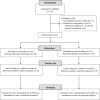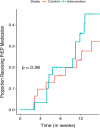A Randomized Study of Passive versus Active PrEP Patient Navigation for a Heterogeneous Population at Risk for HIV in South Florida
- PMID: 31131679
- PMCID: PMC6748484
- DOI: 10.1177/2325958219848848
A Randomized Study of Passive versus Active PrEP Patient Navigation for a Heterogeneous Population at Risk for HIV in South Florida
Abstract
Effective approaches to promoting pre-exposure prophylaxis (PrEP) and linkage to PrEP care among those who may benefit the most from PrEP has proven to be a major challenge. We designed and pilot tested a strengths-based case management (SBCM) intervention for PrEP linkage. Adults interested in PrEP and meeting criteria (n = 61) were randomized to passive referral (control) or active SBCM (treatment). Outcomes measured were completion of provider visit, initiation of PrEP, and time to initiation of PrEP. Overall, 34% initiated PrEP by 12 weeks: 9 (29%) in the control group and 12 (40%) in the treatment group. The mean time to PrEP initiation was 13.1 weeks (95% confidence interval, 12.0-14.2) with no difference between groups ( P = .382). There was a 21% difference in achieving a provider visit between the treatment and control groups (53.3% versus 32.3%) by 12 weeks ( P = .096). Participants encountered financial, logistical, social, and provider-related barriers to PrEP access. Strengths-based case management-based patient navigation is a promising strategy for assisting PrEP seekers in obtaining a medical provider visit and initiating PrEP.
Keywords: HIV prevention; access to care; navigation; pre-exposure prophylaxis.
Conflict of interest statement
Figures
Similar articles
-
Linking women experiencing incarceration to community-based HIV pre-exposure prophylaxis care: protocol of a pilot trial.Addict Sci Clin Pract. 2019 Mar 4;14(1):8. doi: 10.1186/s13722-019-0137-5. Addict Sci Clin Pract. 2019. PMID: 30832717 Free PMC article.
-
Population-level effectiveness of rapid, targeted, high-coverage roll-out of HIV pre-exposure prophylaxis in men who have sex with men: the EPIC-NSW prospective cohort study.Lancet HIV. 2018 Nov;5(11):e629-e637. doi: 10.1016/S2352-3018(18)30215-7. Epub 2018 Oct 17. Lancet HIV. 2018. PMID: 30343026
-
Home-based pre-exposure prophylaxis (PrEP) services for gay and bisexual men: An opportunity to address barriers to PrEP uptake and persistence.PLoS One. 2017 Dec 27;12(12):e0189794. doi: 10.1371/journal.pone.0189794. eCollection 2017. PLoS One. 2017. PMID: 29281688 Free PMC article.
-
A Review of HIV Pre-exposure Prophylaxis Streamlining Strategies.Curr HIV/AIDS Rep. 2020 Dec;17(6):643-653. doi: 10.1007/s11904-020-00528-9. Curr HIV/AIDS Rep. 2020. PMID: 32920764 Free PMC article. Review.
-
Next-Wave HIV Pre-Exposure Prophylaxis Implementation for Gay and Bisexual Men.AIDS Patient Care STDS. 2019 Jun;33(6):253-261. doi: 10.1089/apc.2018.0290. Epub 2019 May 16. AIDS Patient Care STDS. 2019. PMID: 31094576 Free PMC article. Review.
Cited by
-
Contingency Management and Pre-Exposure Prophylaxis Adherence Support Services (CoMPASS): A hybrid type 1 effectiveness-implementation study to promote HIV risk reduction among people who inject drugs.Contemp Clin Trials. 2023 Feb;125:107037. doi: 10.1016/j.cct.2022.107037. Epub 2022 Nov 30. Contemp Clin Trials. 2023. PMID: 36460267 Free PMC article. Clinical Trial.
-
Assessing the Preliminary Efficacy of a Nonrandomized, Clinic-Based HIV Risk Reduction Pilot Intervention for PrEP-Initiated, Alcohol- and Other Drug-Using Women of Color in Miami, FL.J Racial Ethn Health Disparities. 2023 Dec;10(6):3077-3094. doi: 10.1007/s40615-022-01482-5. Epub 2023 Jan 17. J Racial Ethn Health Disparities. 2023. PMID: 36648620 Free PMC article.
-
A Pilot Study of a Patient Navigation Intervention to Improve HIV Pre-exposure Prophylaxis Persistence Among Black/African American Men Who Have Sex With Men.J Acquir Immune Defic Syndr. 2022 Jul 1;90(3):276-282. doi: 10.1097/QAI.0000000000002954. J Acquir Immune Defic Syndr. 2022. PMID: 35312652 Free PMC article. Clinical Trial.
-
Barriers to the Wider Use of Pre-exposure Prophylaxis in the United States: A Narrative Review.Adv Ther. 2020 May;37(5):1778-1811. doi: 10.1007/s12325-020-01295-0. Epub 2020 Mar 30. Adv Ther. 2020. PMID: 32232664 Free PMC article. Review.
-
Engaging Latino sexual minority men in PrEP and behavioral health care: multilevel barriers, facilitators, and potential implementation strategies.J Behav Med. 2023 Aug;46(4):655-667. doi: 10.1007/s10865-022-00371-w. Epub 2022 Dec 6. J Behav Med. 2023. PMID: 36472703 Free PMC article.
References
-
- Molina J-M, Capitant C, Spire B, et al. On demand PrEP with oral TDF-FTC in MSM: results of the ANRS Ipergay trial. In: Conference on Retroviruses and Opportunistic Infections 2015.
-
- Center for Disease Control and Prevention. Diagnoses of HIV infection and AIDS in the United States and dependent areas, 2009. HIV Surveillance Report. 2011;21:1–79.
Publication types
MeSH terms
Substances
Grants and funding
LinkOut - more resources
Full Text Sources
Medical
Miscellaneous



